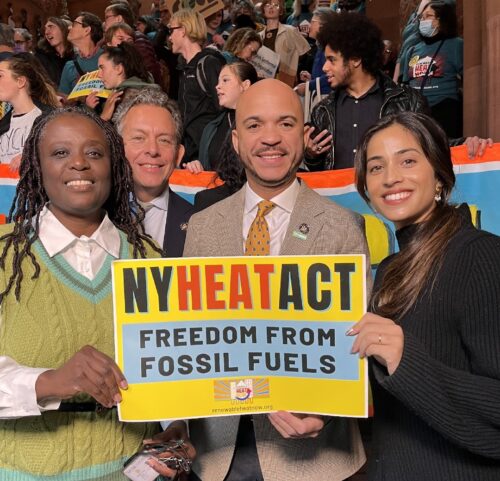With passage of the Climate Leadership and Community Protection Act (CLCPA) in 2019, New York State has committed to emissions reductions goals – reduce emissions to 40 percent below 1990 levels by 2030 and then to 85 percent below 1990 levels by 2050 – to address the climate crisis, which is disproportionately impacting communities of color. The NY HEAT Act (New York Home Energy Affordable Transition) is designed to make energy more affordable while helping advance New York’s transition to renewable energy, ensuring that New York State’s Public Service Law is aligned with the CLCPA. The bill passed the Senate in 2024, and 2023. However, despite being widely popular in the Assembly (it has 75 cosponsors), this critical climate and energy affordability legislation never made it out of the Assembly’s Corporations Committee. Passing this bill (S.4158/A.4870A) would end wasteful ratepayer subsidies to build out more gas infrastructure and curb utility costs for the most energy burdened. It includes the following three provisions:
Ensuring Energy Affordability
Energy affordability has reached a crisis level in New York State, with 1.4 million New Yorkers having struggled to pay their energy bills this past winter. Disadvantaged New Yorkers – particularly people of color and low-income – face the greatest burden because they are required to spend, on average, a disproportionate amount of their household income on energy bills. On top of that, they are more likely to live in older, less energy-efficient homes that require more energy to heat and cool – raising their energy bills even higher. And the situation will only get worse as the climate crisis brings even more extreme weather to our state. That is why this legislation seeks to place a 6 percent of household income cap on energy bills for low-income customers (the State committed to this back in 2016 but never acted on it, so this would codify it).
Ending the Obligation to Serve
The Public Service Law was created to give utilities an “obligation to serve” anyone looking to become a customer. However, in New York State, utilities have an obligation to serve gas, meaning anyone who requests gas service is obligated to get it. The NY HEAT Act seeks to limit that obligation for natural gas, which would give utilities more flexibility in transitioning communities from natural gas to renewable energy, as mandated by the CLCPA.
Ending the 100-foot Rule
The 100-foot rule is part of the obligation to serve under aforementioned Public Service Law. It specifically requires utilities to build a gas pipeline to any building or home within 100 feet of an existing gas main at no cost to the customer. However, ratepayers are forced to subsidize this unnecessary infrastructure to the tune of $200 million a year. And both the CLCPA mandate to transition to renewables and New York State’s All-Electric Building Law (which takes effect in 2026 for buildings up to 7 stories and 2029 for taller buildings) eliminate the need for these gas hookups.
